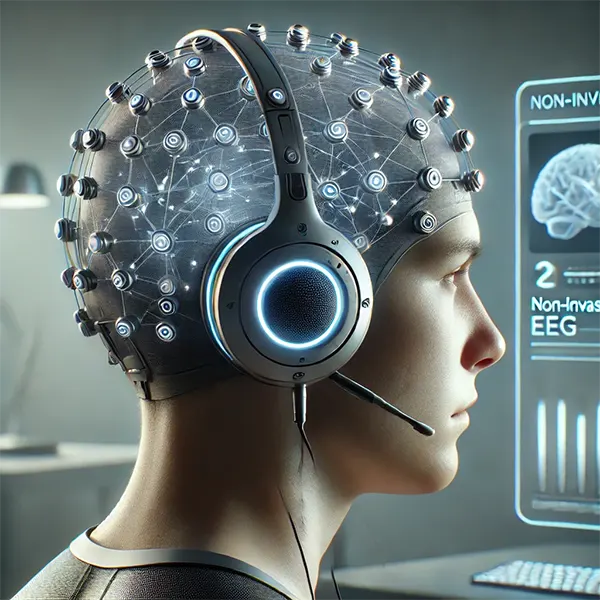
Next-Generation Neurointerfaces: How the Brain Controls Machines Without Implants
Neurotechnology is advancing at an unprecedented pace, allowing humans to control digital systems and machines using only their thoughts. Unlike traditional brain-computer interfaces (BCIs) that require surgical implantation, modern non-invasive solutions are making this technology more accessible than ever. These new-generation neurointerfaces open doors to groundbreaking applications in medicine, gaming, assistive technologies, and even workplace productivity.
By harnessing the power of neural signals, researchers are developing innovative ways to interpret brain activity without the need for invasive procedures. This means that controlling a robotic limb, operating a computer, or even playing a video game with just your mind is no longer the realm of science fiction. But how exactly do these systems work, and what are the challenges they must overcome?
How Do Non-Invasive Neurointerfaces Work?
Non-invasive BCIs function by detecting and interpreting electrical, magnetic, or blood-flow-related signals from the brain. Unlike implantable interfaces, which require electrodes to be surgically placed inside the brain, non-invasive solutions use external sensors to capture these signals. The most common methods include electroencephalography (EEG), functional near-infrared spectroscopy (fNIRS), and magnetoencephalography (MEG).
These technologies translate neural activity into digital commands that can be processed by computers or electronic devices. The challenge, however, lies in the accuracy and resolution of these signals. While invasive BCIs have direct access to neurons, non-invasive systems must filter out noise and external interference, making data processing and interpretation more complex.
EEG-Based Neurointerfaces
EEG is the most widely used non-invasive BCI technology. It works by placing electrodes on the scalp to detect electrical activity in different brain regions. EEG is valued for its affordability, portability, and real-time data processing capabilities. It has already enabled individuals with severe physical disabilities to operate wheelchairs, communicate through thought-controlled keyboards, and even interact with virtual environments.
One of the major advantages of EEG-based neurointerfaces is their ability to function without surgical intervention. However, they also have limitations, including lower spatial resolution and susceptibility to interference from muscle movements or external electrical sources. Researchers are actively working on improving signal clarity through advanced filtering techniques and artificial intelligence.
fNIRS and MEG: Alternative Approaches
Functional near-infrared spectroscopy (fNIRS) is another promising method that measures changes in blood flow and oxygenation levels in the brain. This technology provides valuable insights into cognitive activity and is being explored for applications such as cognitive load monitoring and neurorehabilitation.
Magnetoencephalography (MEG) records the magnetic fields generated by neuronal activity, offering high spatial and temporal resolution. While MEG is extremely precise, it requires expensive and complex equipment, limiting its widespread use. As technology progresses, researchers aim to develop more compact and cost-effective MEG systems for broader applications.
Applications of Non-Invasive BCIs
The potential applications of non-invasive neurointerfaces are vast, spanning multiple industries and offering new possibilities for human-computer interaction. As this technology evolves, we are witnessing revolutionary breakthroughs that could redefine accessibility, communication, and entertainment.
Medical Rehabilitation and Assistive Technologies
For individuals with paralysis or neurodegenerative diseases, non-invasive BCIs represent a life-changing innovation. By translating brain signals into commands, these systems enable users to control robotic limbs, operate communication devices, and interact with digital interfaces without physical movement.
One of the most promising areas of development is neurorehabilitation for stroke patients. BCIs can help rewire neural pathways by encouraging brain activity in affected regions, potentially aiding in the recovery of lost motor functions. Researchers are also exploring the integration of neurofeedback techniques to enhance cognitive and motor rehabilitation.
Brain-Controlled Gaming and Virtual Reality
Brain-controlled gaming is an emerging trend that aims to enhance immersion and accessibility in the gaming industry. Companies are developing BCI-based headsets that allow players to interact with virtual environments using brain signals alone. These systems could benefit individuals with mobility impairments, making gaming more inclusive.
Additionally, the integration of BCIs with virtual and augmented reality (VR/AR) could create entirely new forms of digital experiences. Imagine navigating a virtual world, selecting objects, or interacting with characters simply through thought. This concept is already being tested in research labs, bringing us closer to a future where mind-controlled entertainment becomes mainstream.
Enhancing Productivity and Cognitive Monitoring
BCIs are not limited to entertainment and healthcare—they are also being explored as tools for workplace productivity. Neurointerfaces can monitor cognitive states, detecting signs of fatigue, stress, or lapses in attention. This data could be used to optimise workflows, improve concentration, and reduce workplace burnout.
In high-risk professions such as aviation and military operations, neurointerfaces could serve as an additional safety measure by detecting cognitive overload or impaired decision-making. By integrating BCIs into existing monitoring systems, organisations can ensure safer and more efficient operations.

Challenges and Future Prospects
Despite significant progress, non-invasive BCIs still face several challenges. The primary limitation is the accuracy and reliability of signal detection. Since these systems rely on external sensors, they are susceptible to noise, making it difficult to differentiate between intentional brain signals and background activity.
Another challenge is the need for extensive training. Users often require practice sessions to train the system to recognise their brain signals accurately. This learning curve can be a barrier to widespread adoption, but improvements in machine learning and AI-driven signal processing are helping to address this issue.
Looking ahead, researchers are working on developing wearable, user-friendly neurointerfaces that provide seamless interaction without requiring cumbersome headsets or gels. The goal is to create lightweight, comfortable, and highly responsive systems that integrate effortlessly into daily life.
The Future of Mind-Controlled Technology
The future of neurointerfaces is incredibly promising. As sensor technology advances and AI-driven signal processing improves, we can expect neurointerfaces to become more accurate, efficient, and affordable. Potential developments include neural earbuds, smart glasses with integrated BCIs, and even clothing embedded with neuro-sensing fabric.
Beyond individual applications, the rise of neurotechnology raises ethical and privacy concerns. As BCIs become more powerful, ensuring data security and protecting users’ cognitive privacy will be critical. Regulations and ethical guidelines will need to evolve alongside technological advancements to ensure responsible and fair use.
In the coming years, neurointerfaces will continue to push the boundaries of human-machine interaction, unlocking new possibilities across industries. Whether in medicine, entertainment, or productivity, the ability to control devices with thought alone represents a remarkable step forward in technology and human capability.
